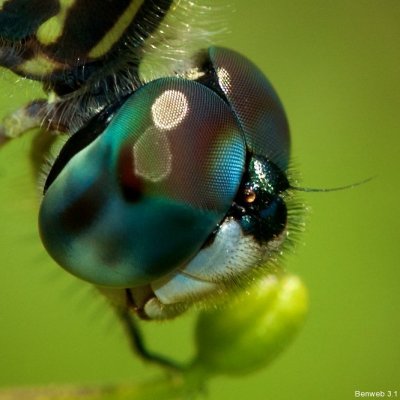For those who know a few dead languages, it probably comes as no surprise that dragonflies have excellent vision. The very word dragon (via Latin draco, from the Greek δρακοιν) means “to see clearly.” And, as the late Philip Corbet noted in his magnum opus, “no other insects have compound eyes that are larger or contain more ommatidia [facets]. … The visual field of the adult is almost 360°: the dragonfly can see in all directions except directly behind the head, where the wings and body interrupt vision—a fact quickly learned by successful dragonfly collectors.”
Here is a photo of the dragonfly eye:

Below is my version, of a very cooperative Blue Dasher in the backyard:
And, for equal representation, a fantastic image of the damselfly eyes, by Slovakian photographer Dusan Beno:
Compound eyes are made up of thousands of repeating units called ommatidia, and, at least as found in insect eyes, the word is almost always plural. It would be pretty hard to have a compound eye with just one ommatidium! [That would be an ocellus, although ocelli are also always plural. The three dots (two blue, one black) on the forehead of that amazing close-up of the damselfly are the three ocelli, or simple eyes, that are found on all odonates.]
The diminutive form of the Greek word omma (“eye”) is ommatidium, and that’s what 19th-century anatomists latched onto when they were deciding what to call these amazing sensory organs found in the highly visual insects (Odonata, Hymenoptera, and a few other orders). Each ommatidium consists of a lens, a cone, visual cells, and pigment cells. The composite image provided by all of these individual lenses is a mosaic; as with the half-tones of photographic reproduction, the finer the mosaic, the clearer the image.
The two different types of eye found in odonates have, as you might suspect, two different functions. The ocelli excel as “light meters,” while the ommatidia function, in their thousands, as form and motion receptors. The more of them an insect has, the more acute their vision is.
More on this in a later post.
References
Corbet, P. 1999. Dragonflies: Behavior and Ecology of Odonata. Ithaca: Cornell UP


